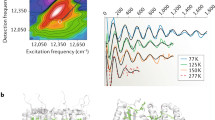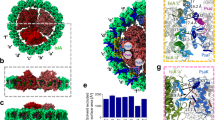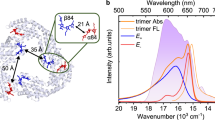Abstract
Recent evidence suggests that quantum coherence enhances excitation energy transfer (EET) through individual photosynthetic light-harvesting protein complexes (LHCs). Its role in vivo is unclear however, where transfer to chemical reaction centres (RCs) spans larger, multi-LHC/RC networks. Here we predict maximum coherence lengths possible in fully connected chromophore networks with the generic structural and energetic features of multi-LHC/RC networks. A renormalization analysis reveals the dependence of EET dynamics on multiscale, hierarchical network structure. Surprisingly, thermal decoherence rate declines at larger length scales for physiological parameters and coherence length is instead limited by localization due to static disorder. Physiological parameters support coherence lengths up to ∼ 5 nm, which is consistent with observations of solvated LHCs and invites experimental tests for intercomplex coherences in multi-LHC/RC networks. Results further suggest that a semiconductor quantum dot network engineered with hierarchically clustered structure and small static disorder may support coherent EET over larger length scales, at ambient temperatures.
This is a preview of subscription content, access via your institution
Access options
Subscribe to this journal
Receive 12 print issues and online access
$209.00 per year
only $17.42 per issue
Buy this article
- Purchase on Springer Link
- Instant access to full article PDF
Prices may be subject to local taxes which are calculated during checkout


 ).
).
Similar content being viewed by others
References
Engel, G. S. et al. Evidence for wavelike energy transfer through quantum coherence in photosynthetic systems. Nature 446, 782–786 (2007).
Lee, H., Cheng, Y-C. & Fleming, G. R. Coherence dynamics in photosynthesis: Protein protection of excitonic coherence. Science 316, 1462–1465 (2007).
Calhoun, T. et al. Quantum coherence enabled determination of the energy landscape in light-harvesting complex II. J. Chem. Phys. B 113, 16291–16295 (2009).
Schlau-Cohen, G. S. et al. Pathways of energy flow in LHCII from two-dimensional electronic spectroscopy. J. Phys. Chem. B 113, 15352–15363 (2009).
Collini, E. et al. Coherently wired light-harvesting in photosynthetic marine algae at ambient temperature. Nature 463, 644–647 (2010).
Panitchayangkoon, G. et al. Long-lived quantum coherence in photosynthetic complexes at physiological temperature. Proc. Natl Acad. Sci. USA 107, 12766–12770 (2010).
Olaya-Castro, A., Lee, C. F., Fassioli Olsen, F. & Johnson, N. F. Efficiency of energy transfer in a light-harvesting system under quantum coherence. Phys. Rev. B 78, 085115 (2008).
Plenio, M. B. & Huelga, S. F. Dephasing-assisted transport: Quantum networks and biomolecules. New J. Phys. 10, 113019 (2008).
Mohseni, M., Rebentrost, P., Lloyd, S. & Aspuru-Guzik, A. Environment-assisted quantum walks in photosynthetic energy transfer. J. Chem. Phys. 129, 174106 (2008).
Caruso, F., Chin, A. W., Datta, A., Huelga, S. F. & Plenio, M. B. Highly efficient energy excitation transfer in light-harvesting complexes: The fundamental role of noise-assisted transport. J. Chem. Phys. 131, 105106 (2009).
Thorwart, M., Eckel, J., Reina, J. H., Nalbach, P. & Weiss, S. Enhanced quantum entanglement in the non-Markovian dynamics of biomolecular excitons. Chem. Phys. Lett. 478, 234–237 (2009).
Roden, J., Strunz, W. T. & Eisfeld, A. Non-Markovian quantum state diffusion for absorption spectra of molecular aggregates. J. Chem. Phys. 134, 034902 (2011).
Prior, J., Chin, A. W., Huelga, S. F. & Plenio, M. B. Efficient simulation of strong system-environment interactions. Phys. Rev. Lett. 105, 050404 (2010).
Jang, S. Theory of coherent resonance energy transfer for coherent initial condition. J. Chem. Phys. 131, 164101 (2009).
Strümpfer, J. & Schulten, K. Light harvesting complex II B850 excitation dynamics. J. Chem. Phys. 131, 225101 (2009).
Ishizaki, A. & Fleming, G. R. Theoretical examination of quantum coherence in a photosynthetic system at physiological temperature. Proc. Natl Acad. Sci. USA 106, 17255–17260 (2009).
Ishizaki, A. & Fleming, G. R. Unified treatment of quantum coherent and incoherent hopping dynamics in electronic energy transfer: Reduced hierarchy equation approach. J. Chem. Phys. 130, 234111 (2009).
Rebentrost, P., Mohseni, M., Kassal, I., Lloyd, S. & Aspuru-Guzik, A. Environment-assisted quantum transport. New J. Phys. 11, 033003 (2009).
Rebentrost, P., Chakraborty, R. & Aspuru-Guzik, A. Non-Markovian quantum jumps in excitonic energy transfer. J. Chem. Phys. 131, 184102 (2009).
Chin, A. W., Datta, A., Caruso, F., Huelga, S. F. & Plenio, M. B. Noise-assisted energy transfer in quantum networks and light-harvesting complexes. New. J. Phys. 12, 065002 (2010).
Hoyer, S., Sarovar, M. & Whaley, K. B. Limits of quantum speedup in photosynthetic light harvesting. New J. Phys. 12, 065041 (2010).
Sarovar, M., Ishizaki, A., Fleming, G. R. & Whaley, K. B. Quantum entanglement in photosynthetic light-harvesting complexes. Nature Phys. 6, 462–467 (2010).
Lloyd, S. & Mohseni, M. Symmetry-enhanced supertransfer of delocalized quantum states. New J. Phys. 12, 075020 (2010).
Liang, X-T. Excitation energy transfer: Study with non-Markovian dynamics. Phys. Rev. E 82, 051918 (2010).
Ishizaki, A., Calhoun, T. R., Schlau-Cohen, G. S. & Fleming, G. R. Quantum coherence and its interplay with protein environments in photosynthetic electronic energy transfer. Phys. Chem. Chem. Phys. 12, 7319–7337 (2010).
Scholak, T., de Melo, F., Wellens, T., Mintert, F. & Buchleitner, A. Efficient and coherent excitation transfer across disordered molecular networks. Phys. Rev. E 83, 021912 (2011).
Sarovar, M., Cheng, Y-C. & Whaley, K. B. Environmental correlation effects on excitation energy transfer in photosynthetic light harvesting. Phys. Rev. E 83, 011906 (2011).
Womick, J. M. & Moran, A. M. Vibronic enhancement of exciton sizes and energy transport in photosynthetic complexes. J. Phys. Chem. B 115, 1347–1356 (2011).
Dekker, J. P. & Boekema, E. J. Supramolecular organization of thylakoid membrane proteins in green plants. Biochim. Biophys. Acta 1706, 12–39 (2005).
Drews, G. & Golecki, J. R. Anoxygenic Photosynthetic Bacteria (Kluwer Academic, 1995).
Fassioli, F., Olaya-Castro, A., Scheuring, S., Sturgis, J. N. & Johnson, N. F. Energy transfer in light-adapted photosynthetic membranes: From active to saturated photosynthesis. Biophys. J. 97, 2464–2473 (2009).
Lambrev, P. H. et al. Functional domain size in aggregates of light-harvesting complex II and thylakoid membranes. Biochim. Biophys. Acta 1807, 1022–1031 (2011).
Spano, F. C., Clark, J., Silva, C. & Friend, R. H. Determining exciton coherence from the photoluminescence spectral line shape in poly(3-hexylthiophene) thin films. J. Chem. Phys. 130, 074904 (2009).
Hildner, R., Brinks, D. & van Hulst, N. F. Femtosecond coherence and quantum control of single molecules at room temperature. Nature Phys. 7, 172–177 (2011).
Horton, P., Johnson, M. P., Perez-Bueno, M. L., Kiss, A. Z. & Ruban, A. V. Photosynthetic acclimation: Does the dynamic structure and macro-organisation of photosystem II in higher plant grana membranes regulate light harvesting states? FEBS J. 275, 1069–1079 (2008).
Broess, K., Trinkunas, G., van Hoek, A., Croce, R. & van Amerongen, H. Determination of the excitation migration time in photosystem II—Consequences for the membrane organization and charge separation parameters. Biochim. Biophys. Acta 1777, 404–409 (2006).
Miloslavina, Y. et al. Far-red fluorescence: A direct spectroscopic marker for LHCII oligomer formation in non-photochemical quenching. Fed. Euro. Biochem. Soc. Lett. 582, 3625–3631 (2008).
Ritz, T., Park, S. & Schulten, K. Kinetics of excitation migration and trapping in the photosynthetic unit of purple bacteria. J. Phys. Chem. 105, 8259–8267 (2001).
Scholes, G. D. Designing light-harvesting antenna systems based on superradiant molecular aggregates. Chem. Phys. 275, 373–386 (2002).
Jang, S. J., Newton, M. D. & Silbey, R. J. Multichromophoric Förster resonance energy transfer. Phys. Rev. Lett. 92, 218301 (2004).
Lambrev, P. H. et al. Importance of trimer-trimer interactions for the native state of the plant light-harvesting complex II. Biochim. Biophys. Acta 1767, 847–853 (2007).
Didraga, C., Malyshev, V. A. & Knoester, J. Excitation energy transfer between closely spaced multichromophoric systems: Effects of band mixing and intraband relaxation. J. Phys. Chem. B 110, 18818–18827 (2006).
Mahan, G. Many-Particle Physics (Kluwer Academic/Plenum Publishers, 2000).
Gilmore, J. B. & McKenzie, R. H. Spin boson models for quantum decoherence of electronic excitations of biomolecules and quantum dots in a solvent. J. Phys. Condens. Matter 17, 1735–1746 (2005).
Gilmore, J. B. & McKenzie, R. H. Criteria for quantum coherent transfer of excitations between chromophores in a polar solvent. Chem. Phys. Lett. 421, 266–271 (2006).
Barrett, S. D. & Milburn, G. J. Measuring the decoherence rate in a semiconductor charge qubit. Phys. Rev. B 68, 155307 (2003).
Stace, T. M., Doherty, A. C. & Barrett, S. D. Population inversion of a driven two-level system in a structureless bath. Phys. Rev. Lett. 95, 106801 (2005).
Egger, R., Grabert, H. & Weiss, U. Crossover from coherent to incoherent dynamics in damped quantum systems. Phys. Rev. E 55, R3809–R3812 (1997).
Wilson, K. G. The renormalization group: Critical phenomena and the Kondo problem. Rev. Mod. Phys. 47, 773–840 (1975).
Fisher, D. S., Frölich, J. & Spencer, T. The Ising model in a random magnetic field. J. Stat. Phys. 34, 863–870 (1984).
Acknowledgements
We are grateful to the following people for discussions and comments: B. Hankamer,M. Landsberg, E. Knauth, I. Ross, M. Sarovar, S. Hoyer, B. Whaley, A. Ishizaki, T. Calhoun, G. Schlau-Cohen, N. Ginsberg, J. Dawlaty, G. Fleming, P. Rebentrost,L. Vogt, A. Perdomo, M. Mohseni, A. Aspuru-Guzik, A. Olaya-Castro, S. Jang, R. Pfeifer,P. Rohde, E. Cavalcanti and R. McKenzie. A.K.R. thanks the Whaley and Fleming groups at UC Berkeley, and the Aspuru-Guzik group at Harvard, for hospitality. This work was supported by Australian Research Council grants CE110001013, FF0776191, DP1093287 and DP0986352 and a Dan David Prize doctoral scholarship.
Author information
Authors and Affiliations
Contributions
A.K.R. suggested the multiscale, hierarchical approach of the study. T.M.S. proposed the renormalization analysis. A.K.R. and T.M.S. completed the calculations. A.K.R. wrote, and T.M.S. and G.J.M. edited, the manuscript. G.J.M. supervised the project and advised on calculations.
Corresponding author
Ethics declarations
Competing interests
The authors declare no competing financial interests.
Supplementary information
Supplementary Information
Supplementary Information (PDF 1243 kb)
Rights and permissions
About this article
Cite this article
Ringsmuth, A., Milburn, G. & Stace, T. Multiscale photosynthetic and biomimetic excitation energy transfer. Nature Phys 8, 562–567 (2012). https://doi.org/10.1038/nphys2332
Received:
Accepted:
Published:
Issue Date:
DOI: https://doi.org/10.1038/nphys2332
This article is cited by
-
Local probe for connectivity and coupling strength in quantum complex networks
Scientific Reports (2018)
-
Generation of photonic entanglement in green fluorescent proteins
Nature Communications (2017)
-
Role of an elliptical structure in photosynthetic energy transfer: Collaboration between quantum entanglement and thermal fluctuation
Scientific Reports (2016)
-
Broadband photon pair generation in green fluorescent proteins through spontaneous four-wave mixing
Scientific Reports (2016)
-
Quantum biology: explore quantum dynamics in biological systems
Science China Information Sciences (2016)



